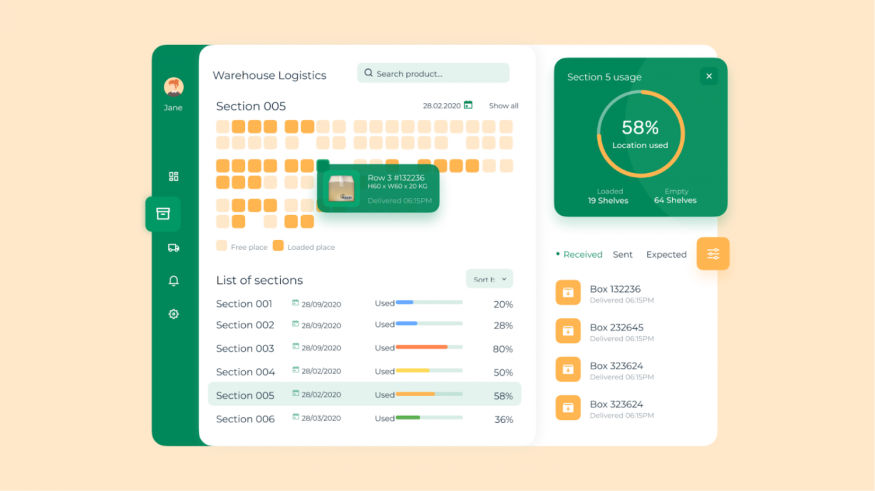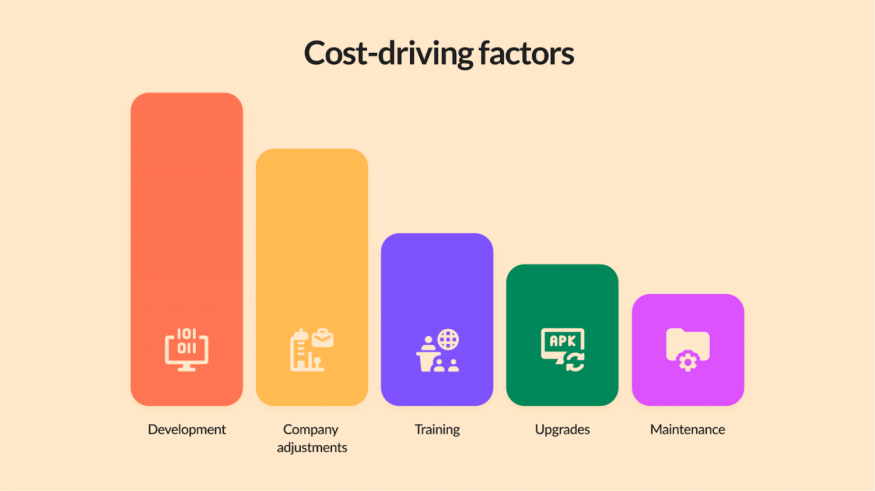Software for enterprise resource planning automates procedures and helps organizations cut back on human labor.
What is ERP software?
The entire potential of a firm may be realized by using an ERP system. This technology makes it easier for businesses to streamline their procedures and reach long-term decisions with confidence. ERP software streamlines administration of all company domains by facilitating inter-system communication. By reducing manual data input, the need for various databases, and providing real-time insights into an organization's activities, ERP integration may help firms become more efficient. This technology may be used in a variety of fields, including sales, supply chain management, accounting, finance, and human resources. These advantages of ERP may result in quicker and more accurate results. Businesses benefit from enterprise resource planning (ERP) because it makes it possible to automate back-office tasks, store and transmit data securely, and maintain a competitive edge.
Software for enterprise resource planning (ERP) collects data from many departments into a single repository and is modular in nature. A chosen department's staff members have access to information pertinent to that department. The experts in ERP software who are in charge of managing corporate operations may access the data from each department.

Benefits of Custom ERP Software
A company's full potential might be realized with the aid of customized ERP software. With customized solutions for every business, this technology may open up new avenues for expansion and innovation. By streamlining procedures and preventing data duplication, the implementation of bespoke Enterprise Resource Planning (ERP) systems may aid in increasing productivity and lowering costs. Efficient employee training provides personnel with the most recent tools and procedures, and greater adaptability helps businesses to react quickly to changes in the market dynamics. Users that utilize ERP solutions have real-time access to operational information and may act quickly. Businesses may streamline routine processes while concentrating on their core values by utilizing a customized ERP system. Businesses that want to maintain their competitiveness in a market that is changing quickly may find that custom ERP software is a valuable tool.
Disadvantages of ERP Software Development
Even while creating an ERP system is undoubtedly a wise investment, everything comes at a cost.
The following are the primary ERP software development pitfalls:
Cost. Most business owners are deterred by the hefty development expenses of ERP software. Using third-party solutions that operate on a subscription basis may be more cost-effective than implementing an enterprise-wide project, which can be pricey. The economic picture for the long run is hazy.
period for development. It takes time for software developers to design the solution, create the business logic, and validate each layer. Don't forget to schedule time for vendor software-related staff training.
locating a spouse. Lastly, a tech-related partner is required. Finding a reliable software development partner could take many months. Prioritize jobs requiring the following if you're working under a tight deadline.
Third-Party vs. Custom-Made Solutions
There are two choices open to business owners when searching for ERP software. Purchasing third-party software through various subscription plans is one choice. The second choice is to create a solution specifically for the business. The benefits and drawbacks of both strategies have been discussed in this section.
Third-Party Solutions
After an initial purchase, software as a service companies provide a variety of Enterprise Resource Planning solutions that may be quickly set up. They are appropriate for small to medium sized organizations and include Acumatica, Sage Intacct, and SAP Business One.
For sophisticated solutions, large firms may employ Oracle NetSuite, Microsoft Dynamics, or SAP S/4 HANA.
Training difficulty is the most difficult of all the difficulties. You may be able to solve software problems on your own as a small business owner. Integration could take months or years to finish when running a big business. SAP and other software vendors provide maintenance officers as an added service to aid in educating your staff about the product. If the speed of integration is the only factor you're evaluating in third-party software, thoroughly analyze all of your choices before deciding.
You may avoid any difficulties related to ERP development by using a third-party solution.
Custom-Made Solutions
Although custom-built solutions are limited only by what may be envisioned, third-party solutions are constrained only by the features designed by their creators. Collaboration across departments can be facilitated by specialized solutions.
Third-party solutions could be deficient in key functionality or offer capabilities that are irrelevant to your company's operations. If the list is established in advance, proper ERP software development can ensure that you have the needed functionality.
Engineers' documentation from the development phase might help responsible staff handle unanticipated issues without consulting outside providers. A technical writer can also be employed to work with developers to produce an exhaustive documentation for the entire system. Benefits of this strategy include accelerating the training process and helping new hires comprehend the workflow.
While building ERP software, two important factors to think about are cost and development time.

The process of developing ERP software.
If you've taken the challenging path, keep in mind that developing ERP solution is a demanding process with numerous factors.
To make the process of developing ERP software more clear, we have listed every stage.
It's crucial to express your idea clearly
It's crucial to clearly express your concept and goals. Clear criteria are necessary for developers to participate in the project's development. Reputable software providers assist their clients in creating feature lists and providing preliminary project estimates when they first get in touch with them.
To provide engineers a better understanding of the software system, you should be able to articulate the underlying structure of your business. The ERP system's whole workflow should be well documented.
Optimizing UI/UX design
Because it contains user roles, navigational features, charts, as well as other dynamic aspects, design is a crucial component of ERP development.
At this phase, structured wireframes are crucial. With the help of wireframes, you may get a general idea of how the components of the app will be placed on the screen. You will analyze this strategy and decide what should be included or left out while working with designers and business analysts.
The arrangement is not the only thing to take into account, though. The usefulness and aesthetics of the finished product may be improved by using the right color schemes, typefaces, buttons, and other tiny things. Consider whether a potential tech partner provides high-quality UI/UX design services when choosing a partner.
Technology Stack
Beyond merely the product's design, factors should be taken into account while choosing an ERP software development business. Engineering teams build an architecture based on the selected platform using various technologies and development methodologies.
Integrations
Businesses frequently include a variety of goods from third parties into their workflow. It should be thought about integrating services like G Suite, Office 365, FreshBooks, and others with the ERP system. Developers of ERP software can access data using third-party APIs, which can subsequently be displayed inside the ERP system. More company data is added to the ERP system to improve it and expand its functionality.
Integrations from outside sources can be utilized to replace certain ERP software development components. The sales department may track points of entry, lead quality, sales pipeline, and other things thanks to customer relationship management (CRM) from small and mid-sized businesses, it could be too expensive to build an ERP module from scratch. By integrating third-party software, businesses may avoid developing a module or transferring data from existing databases, saving both time and money.
Quality Control
This enormous system's testing is a challenging procedure that calls for experienced quality assurance engineers. Answering how to build an ERP system from scratch, several phases of the development process for ERP software testing should be completed.
Unit testing is often done by engineers to determine whether new features will work with already installed software components. The final, completely completed product is put through a system test to make sure it satisfies the initial specifications. Different time blocks must be set up for these two types of testing. In addition to the five different kinds of functional testing, there are five different kinds of non-functional testing.
The costs associated with the development of ERP software.
Pricing is based on a number of factors, including feature count, organization size, and system responsibilities. To this question, there is no unified answer that can be given.
While building a bespoke ERP, it is wise to take the costs into account.
Price Calculation
The price of creating ERP software is complicated and includes a number of costs. Even so, some costs that are unrelated to software development should be considered. The primary determinants of pricing are as follows:
The components of development and integration are essential. Engineers must first build the program. Developers, designers, testers, and project managers make up the team. The most expensive item is ERP software because of its intricacy. ERP requires a lot of resources, so get extra storage or use the cloud.
Training. A new process might be difficult to adjust to. Workers require time to become proficient with the program. Its implementation will lessen the efficiency of the department.
enhancing the business. Several regular jobs are automated by ERP systems, which must adhere to specific requirements. Thus, it is crucial to analyze and replace any antiquated internal procedures in order to ensure compatibility with your ERP solution. Hiring management to create an ERP solution takes time, which adds to the cost.
Maintenance. Hardware that is based in the cloud or on-premises can be used to deploy the ERP system. Network and hardware components have a finite lifetime. The ERP system's components might malfunction and need to be replaced.
Upgrades. Businesses are always changing. Workflow at the firm is continually modified for long-term growth. It is clear that alterations to the workflow will affect the software. Relevant updates are necessary for an effective ERP software development.
ERP system development: cost-driving factors

The cost of creating ERP software depends on a number of variables.
Prices vary based on your company's size and the modules you've ordered, so be sure to include everything in! Typically, a mid-sized business costs between $100,000 and $250,000.











